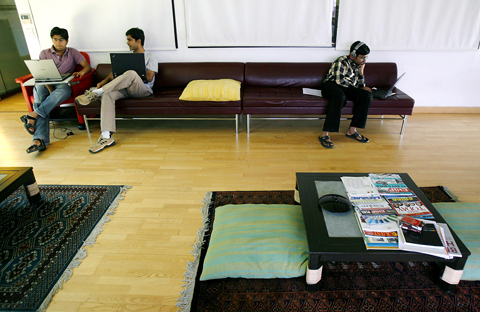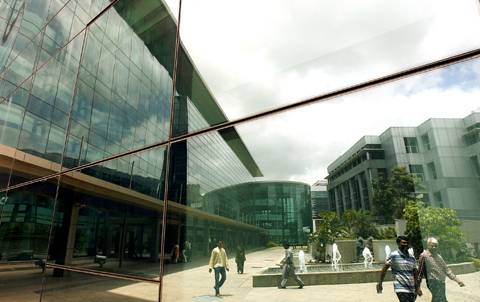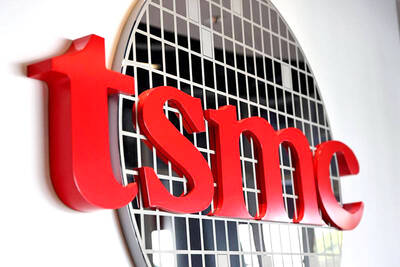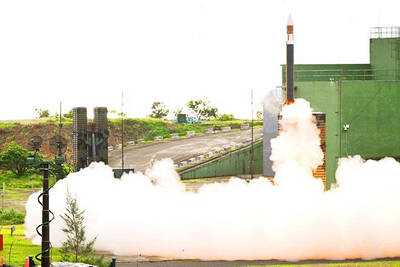Anew generation of researchers is being groomed half a world away from Microsoft’s sprawling Seattle headquarters at Microsoft’s research center on a leafy lane in India’s tech capital.
Complete with beanbags and coffee served in steel tumblers, the center is helping change the perception that India is no place for top-end research and development (R&D).
Staffed with about 60 full-time researchers, many of them Indians with doctorates from top US universities, the center is at the cutting edge of Microsoft’s R&D. It covers seven areas of research, including mobility and cryptography.

PHOTO: REUTERS
Its success, including developing a popular tool for Microsoft’s new search engine Bing, underscores the potential of R&D in India at a time when firms are keen to save money by using talented researchers abroad.
Showing off the Bing tool, which enables searches for locations with incomplete or even incorrect addresses, B. Ashok, a director of a research unit at the center, said the innovation would never have taken root if the R&D had been done in the US.
“It was completely inspired by the Indian environment, but is applicable worldwide,” he said.

PHOTO: REUTERS
India might seem like a natural location to expand offshoring into R&D, but this is hampered by problems that range from not enough home grown researchers to a lack of government support.
India produces about 300,000 computer science graduates a year, but only about 100 computer science doctorates.
“Students here are not exposed to research from an early age, faculties are not exposed to research and there’s no career path for innovation because there’s a lot of pressure to get a ‘real’ job,” said Vidya Natampally, head of strategy at the Microsoft India Research Center.
With few government incentives and an education system that emphasizes rote learning, India lacks the environment found in say, Silicon Valley, where universities and startups encourage innovation.
“China has a policy in place for R&D. We don’t,” Natampally said.
India’s lagging R&D environment is blunting the country’s edge, analysts warn. Rival China has pulled ahead, with more than 1,100 R&D centers, compared with less than 800 in India.
Aside from providing funding to encourage students to pursue doctorates, China offers tax breaks for R&D centers and its special economic zones provide infrastructure for high-tech and R&D industries.
India is also losing out in the patent stakes. In 2006 and 2007, just 7,000 patents were granted in India, compared with nearly 160,000 in the US.
“We’re nowhere near the US or even Israel when it comes to innovations,” said Praveen Bhadada at consultancy Zinnov, which estimates the R&D sector in India is worth about US$9.2 billion. “Our costs are low and our talent pool is ahead of China, Russia and Ukraine, but China gives specific incentives and produces way more PhDs.”
India is cheaper than China for R&D, but salaries have been rising by about 15 percent every year and may soon reach parity with China.
Microsoft and other firms have been working around the government’s indifference.
Cisco, IBM, Intel, Nokia, Ericsson and Suzuki Motor have all gone beyond low-end coding and tweaking products for the local market, with hefty investments and recruitment.
Their success shows India’s potential if the government starts supporting such ventures.
Texas Instruments and San Jose-based Cadence Design were among the first to set up R&D in India in the mid-1980s, drawn by the legions of English-speaking software engineers who could be hired at about 20 percent of the cost of engineers in the US.
The opening of India’s economy in the early 1990s and the establishment of the software services industry drew more foreign firms looking to cut costs and tap emerging markets.
“From when a few companies offshored non-critical design work, we have seen India emerge as a preferred destination for design and development of chip, board and embedded software,” said Jaswinder Ahuja, managing director of Cadence India.
Firms first focused on the “D” in R&D, but research has grown in importance and many of the facilities in India are now the largest outside their home base.
Half of Cisco’s core R&D work, including innovations in WiMAX and optical networks, and about 40 percent of SAP’s ideas for processes and product development come from India.
IBM’s India Research Labs do a “fair share of patenting,” boosting its record numbers every year, director Guruduth Banavar said in Bangalore.
Its new US$100 million-mobile communications research, Mobile Web, is the first time a big project has been driven from outside the US, he said.
“For a research lab, it’s the best environment to be in: You can see the problems and the opportunities,” said Banavar, who was previously at IBM’s lab in Boston and has, like several of his peers, returned to India to oversee operations.

Authorities have detained three former Taiwan Semiconductor Manufacturing Co (TMSC, 台積電) employees on suspicion of compromising classified technology used in making 2-nanometer chips, the Taiwan High Prosecutors’ Office said yesterday. Prosecutors are holding a former TSMC engineer surnamed Chen (陳) and two recently sacked TSMC engineers, including one person surnamed Wu (吳) in detention with restricted communication, following an investigation launched on July 25, a statement said. The announcement came a day after Nikkei Asia reported on the technology theft in an exclusive story, saying TSMC had fired two workers for contravening data rules on advanced chipmaking technology. Two-nanometer wafers are the most

NEW GEAR: On top of the new Tien Kung IV air defense missiles, the military is expected to place orders for a new combat vehicle next year for delivery in 2028 Mass production of Tien Kung IV (Sky Bow IV) missiles is expected to start next year, with plans to order 122 pods, the Ministry of National Defense’s (MND) latest list of regulated military material showed. The document said that the armed forces would obtain 46 pods of the air defense missiles next year and 76 pods the year after that. The Tien Kung IV is designed to intercept cruise missiles and ballistic missiles to an altitude of 70km, compared with the 60km maximum altitude achieved by the Missile Segment Enhancement variant of PAC-3 systems. A defense source said yesterday that the number of

A bipartisan group of US representatives have introduced a draft US-Taiwan Defense Innovation Partnership bill, aimed at accelerating defense technology collaboration between Taiwan and the US in response to ongoing aggression by the Chinese Communist Party (CCP). The bill was introduced by US representatives Zach Nunn and Jill Tokuda, with US House Select Committee on the Chinese Communist Party Chairman John Moolenaar and US Representative Ashley Hinson joining as original cosponsors, a news release issued by Tokuda’s office on Thursday said. The draft bill “directs the US Department of Defense to work directly with Taiwan’s Ministry of National Defense through their respective

Tsunami waves were possible in three areas of Kamchatka in Russia’s Far East, the Russian Ministry for Emergency Services said yesterday after a magnitude 7.0 earthquake hit the nearby Kuril Islands. “The expected wave heights are low, but you must still move away from the shore,” the ministry said on the Telegram messaging app, after the latest seismic activity in the area. However, the Pacific Tsunami Warning System in Hawaii said there was no tsunami warning after the quake. The Russian tsunami alert was later canceled. Overnight, the Krasheninnikov volcano in Kamchatka erupted for the first time in 600 years, Russia’s RIA